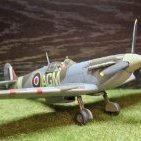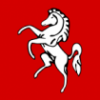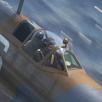-
Posts
5,499 -
Joined
-
Last visited
About Edgar
- Birthday 08/10/1940
Contact Methods
-
Website URL
http://
Profile Information
-
Gender
Male
-
Location
High Wycombe, Bucks.
Recent Profile Visitors
12,936 profile views
Edgar's Achievements

Completely Obsessed Member (6/9)
915
Reputation
-
The stiffeners were fitted, to the Va & Vb, from 16-7-42. Any Mk.I & 2 aircraft, in training units, which needed a damaged wing to be replaced, usually had the Mk.V versions fitted. The Vc also had strengthening fitted, but it was normally internal to the wells, and was fitted from 14-8-42.
-
Upper wing roundels were produced to a set formula, and their size depended, largely, on the chord; take the wingspan, divide by 3, measure that distance out from the fuselage centre line, and that sets the centre of the roundel. Each roundel was supposed to fill the available space, without encroaching on the aileron, de-icer boot, or yellow leading edge.
-
"Two chutes for landing flares" were fitted, as visible in that photo, from September 1936, and the launching was improved from July 1940. One tube was deleted, on the Mark V, in November 1941; I've no idea when the other was deleted. 14-6-40 an "automatic recognition device" (rather like a Colt six-gun, minus handle and barrel) was fitted, set to fire downwards, roughly level with the position of the starboard access hatch. This was removed, and replaced in the fuselage spine, so as to fire upwards, in April 1941. 13-6-40 a "means of draining the fuselage" was introduced, which could, quite simply, be the hole near the tail wheel. It's much too far back to be the automatic recognition device.
-
Heating was introduced 26-5-38
-

How Green Was My Interior - or was it grey? plus info on BS381
Edgar replied to John's topic in Aircraft WWII
Not my style. -
2-6-40 an order was issued that underside roundels should be painted as large as possible without encroaching on the ailerons. 10-6-40 a notification was issued that, due to shortage of Sky, black/white scheme would remain for now. 12-6-40 Glosters (and presumably other manufacturers) were told to remove the black/white plus roundels and start painting fighters in Sky, with immediate effect.
-

How Green Was My Interior - or was it grey? plus info on BS381
Edgar replied to John's topic in Aircraft WWII
It isn't a case of attitude; I have travelled all over this country, calling on various rebuilders, and I photographed those seats (and others) because of their different shades of green (and I've never been diagnosed as colour blind.) Now I'm told that, in spite of 50+ years experience in photography, my photos can't be trusted; however a photo of a civilian aircraft, built in 1932, crashed and written off in 1938, then spent 35 years in wind, snow, rain and sun on a Scottish hillside, is accepted, without question, as having a pristine example of a wartime airframe interior. At the moment I'm too unwell to bother with getting involved in this thread, any more, but, with other contentious threads over the last few weeks, it is becoming plain, to me, that, if one aspect of my research can't be trusted, then neither can the rest, so what is the point of continuing with what is becoming a complete waste of time? -

How Green Was My Interior - or was it grey? plus info on BS381
Edgar replied to John's topic in Aircraft WWII
So, no matter how often I tell you that British Standards said that they had nothing to do with wartime aircraft colours, you persist in trying to find some (non-existent) link. Truly I am wasting my time in my researches, so it is time for me to quit and tell you to do your own. -

How Green Was My Interior - or was it grey? plus info on BS381
Edgar replied to John's topic in Aircraft WWII
waste of time -
This is the other side of the same seat, and the fastening is clear of any moving parts; I've no idea of the Mark, since it was sitting in the middle of an aircraft rebuilder's shop floor, surrounded by half a dozen airframes (Mk.IX would seem favourite, though.)
-

How Green Was My Interior - or was it grey? plus info on BS381
Edgar replied to John's topic in Aircraft WWII
waste of time -
I haven't seen a seat with the early Sutton arrangement, so can only guess that they used, somehow, the stiffening bar underneath as an anchor point. The pin wasn't fitted to strap 2 (actually right thigh) or 3 (left thigh); it was on strap 1 (left shoulder,) and the clip was attached to strap 4 (right shoulder.) With no mechanism on the left seat wall, there was no need for a slot. The "flare," on the left wall, was to give the ripcord room, so that it didn't chafe; it was also lined with basil leather, to help with that. The slot, in the backrest, remains a bone of contention; on metal seats it was designed for the shoulder straps to pass through, but a friend, who works on Spitfires, maintains that the plastic would never have coped with the strain; he also points out that you never see marks, on the slot, which would have been caused by the straps. He uses it as a simple handhold, since the Spitfire seat can only be removed with it at the lowest point of its travel, and, especially with the extra weight of armour plate, it takes two to lift it out, and a third to take it from them.
-
Strange, that, when the above instruction just calls for "plain Mediterranean blue." Perhaps you should consider the possibility that Dark and Light only appeared when one was lightened into an underside colour. I don't have the chip (it belongs in Kew, after all.)
-

How Green Was My Interior - or was it grey? plus info on BS381
Edgar replied to John's topic in Aircraft WWII
waste of time









